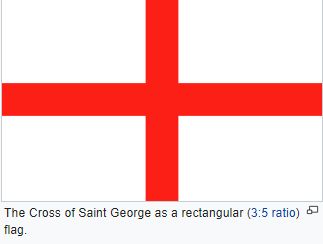
Go to Main Body - Battle of Hastings in 1066
Go to End - Queen Elizabeth II in 1952
Those Englanders, Anglers, Engels and Angels
Thoughts from an email sent Saturday, April 3rd, 2010
Hi all
Wonderful, how the Internet opens up so many beaut hyperlinks. Here's one to Angeln , a small area in modern Germany, and from where it's often thought the original "Angles / Engels" came to England.
Its etymology is thought to be linked to a word meaning "Angling" for fish, brilliant, especially after chatting about Peter and the fishermen on Wednesday, from their enormous catch (in Greek — agra) of fish, to their catching (in Greek — zo-agreo) of men.
Because it also appears to be linked to "Engels", the German word for angels — messengers — bringers of information about events (in Greek — aggelos — pronounced ang-el-os).
Further thoughts are below, based on an article by "Palaver", I was reading at Yahoo Answers.
Blessings from Steve
Why England. not Saxonland?
The Angles, from which we get the name England, were invited by a tribal British king, King Vortigern to come to Britain about 450 AD, after majority of Roman troops left ca 407. The meaning of their name derives from a German word "Angeln" and is thought to mean "hook", as in angling for fish. Interestingly, the name is also closely linked to a different word with very similar spelling: "Engel" in German, also Dutch, Norwegian and Danish, which derives its meaning from the Latin word "angelus" and the Greek word "angelos" meaning "the messenger", yes, and from which we get those English words "angel", and "evangelist" meaning "good news messenger". Chance, perhaps ? Maybe not.
The original use of the name Angli (for the people) and Anglia (for the country) is found in Latin writers during the seventh century, but only with reference to these Angles (as opposed to the Saxons and Jutes) e.g. a king of Kent, Aethelbert (540-616), is called "rex Anglorum" — "king of the Angles". And certainly Bede (672-735) never uses Anglia for the country as a whole: his name was Brittania or Britannia i.e. "Britain".
As a bynote, it was this king Aethelbert, and particularly his Frankish queen Bertha, daughter of the king in Paris, who, later in their lives, welcomed Augustine as a missionary in 596, when he brought a party of men from Rome along with a team of Frankish interpreters. Presumably these interpreters understood both Latin and the language of Anglia. Needless to say, the good news of God's son, of God's forgiveness, of doing unto others as you would have them do unto you, of turning the other cheek, was found to be a welcome message, with thousands in Kent being baptised as a result. Schools were opened, some of which are still functioning today.
So with these Angles, if they established themselves in one part of the country (i.e. on the East coast, then moved north into Northumbria and Mercia), while the Saxons settled in the rest of the country (i.e. South West, or Wessex and South South, or Sussex and South East or Essex), why did the name of the modern country derive from the former rather than the latter? The historical evidence, though meagre, does not suggest that the Angles were any more numerous than the Saxons, or had greater military successes. Why, then, is the country called England, and not Saxonland, Sax land, or some other such form? It is a puzzle, but we can make some guesses.
The one context where the early Latin writers did give the Angl- element prominence was in the phrase Angl- Saxones, used at least from the eighth century to mean the "English Saxons" (of Britain) as opposed to the 'Old Saxons' (on the Continent). A long time afterwards, as the historical facts began to blur in the popular mind, Anglo-Saxons came to be interpreted as "Angles and Saxons", the combined Germanic people of Britain, which is how the term is used today.
But back in the eighth century Angl- did not have this sense. Rather, it was the crucial, contrastive element in the phrase "the English Saxons", as opposed to other kinds. Issues of identity being so important, perhaps it was this prominence which fixed Angl- in the intuitions of the people, as a label for the people as a whole?
Whatever the reason, we can see the name Angl- broadening its meaning in the ninth century, with the forms Angel- and Engl- now being found as well. The adjective English referring to all the people, makes its first appearance at that time. In a treaty made between King Alfred and the Dane Guthrum (around 880) we see English, as opposed to Danish, and it plainly refers to all of the non-Danish population, not just the Angles. At around the same time, also, English is used for the language: Alfred's translation of Bede at one point (Book III, Chapter 19) talks about a monastery "nemned on Englisc" — "called in English" Cneoferisburh, and Alfred quite often uses the name in this way. And in translating the Latin phrase "in regione Anglorum" (Book IV, Chapter 26), referring to the country of the Angles, we now find the phrase "on Engla lande".
Still, it took over a century before we find the phrase Engla lande referring to the whole country — by the writers of the eleventh-century Anglo-Saxon Chronicle to be precise. There was then a long period of varied usage, and we find such forms as Engle land, Englene londe, Engle lond, Engelond, and Ingland. The spelling England emerged in the fourteenth century, and soon after became established as the norm.
The forming of the UK, the United Kingdom click here for a brief timeline.
In 927 came the Kingdom of England (or Engla lande) under Æthelstan, established by the unification of Anglo-Saxon tribes across modern day England. Much preparatory work had been done by his grandfather, Alfred the Great, King of the Anglo-Saxons (886-899) who had fought off Viking invasions and encouraged the use of Anglo-Saxon (Old English) in place of Latin in primary education.
Click here for the last, short-lived Anglo-Saxon King, Harold, the brother of King Edward the Confessor's wife when Edward died without heirs in 1066.
William the Conqueror (1066-1087) great-nephew of Edward the Confessor's mother and Duke of Normandy, who invaded England in 1066 and claimed the throne. Married to Matilda of Flanders who was granddaughter of King Robert of France and who spent most of her time in Normandy, bringing up their children. Matilda died before her husband in 1083. Their eldest son, Robert, inherited Normandy in 1087. Their second son died early, so William's third son inherited the throne of England as William II (1087-1100).
William II had no children, so upon his death his youngest brother Henry I (1100-1135) became king. Henry I had only one legitimate son, but he died young, so Henry named his daughter Matilda his heir in Normandy. Upon Henry's death in 1135, Henry's sister's son Stephen (1135-1154), was the son of the Count of Blois in France, but he had grown up in his uncle King Henry's court in England. He was now ready to take the English throne.
Over in France, Henry's daughter Matilda had married Geoffrey of Anjou, a man who'd grown up with the nickname "Plante Genest" (Sprig of Broom) or "Plantagenet", and with whom she'd had the son Henry of Anjou in 1133. In 1153, this Henry, now of age, and considering himself the rightful heir to his grandfather's throne in England, invaded England with a small army. After a number of victories, Stephen agreed to surrender the throne to him upon his death, which came the following year. Henry then succeeded Stephen as Henry II.
Plantagenet dynasty Henry II (1154-1189) saw his sons fighting amongst themselves over their inheritance. Upon his death, he was succeeded by his son
In 1295, the English Parliament opened, and the ennoblement by the king via "knighthoods". Along with nobles and clergy, parliament required the presence from every city of two Citizens, from every borough (village) of two Burgesses, and from every county shire of two Knyghts (an English word signifying trained military attendants), milites comitatus ("County Soldiers") in Latin, chevaliers ("Cavalry") in French. A Knight on campaign could command a daily payment of two shillings, compared with one shilling for a man at arms, and 2d or 3d for a foot archer. Good money in those days. Elections of representatives were conducted locally, noting as well there were no secret ballots until 1872. The population of course was much smaller. There was one House of Parliament in England until 1345, when House of Lords, the nobles and clergy, separated from the House of Commons.
The Edict of Expulsion on another note, a royal decree in 1290 by Edward I, expelled all Jews from England. This lasted until it was repealed by Oliver Cromwell in 1655.
Looking at Genesis 12:3, God's blessing and cursing of the nations aligning with their treatment of the Hebrew people, it is perhaps not surprising that the reigns in England of Edward I's son Edward II (1307-1327) and his grandson Edward III (1327-1377) were filled with disasters.
Edward II's reign saw a major defeat in Scotland to Robert the Bruce in 1314, a widespread famine in England in 1315, and ongoing war with the barons. Edward had married Isabella the daughter of the King of France, but in 1325 she went to Paris and aligned herself to an exiled baron there, Roger Mortimer. Roger returned to England, defeating Edward, with Edward's death in prison following shortly after at the young age of 43. Isabella now became regent for three years (1327-1330) on behalf of their young son Edward III. More disasters followed shortly after with the Bubonic Plague (Black Death in England) 1348-1349 and 1361-1362, when perhaps 50% of the population died. "Bring out your dead". A horrendous time.
 |
During this period, particularly after 1348, the House of Plantagenet adopted the
Over to France. In 1328, Isabella's brother King Charles IV of France died without sons or brothers and his closest male relative was his nephew Edward III of England. Isabella claimed the throne of France for her son, but the throne passed instead to Charles's patrilineal cousin, Philip, Count of Valois. The English had not expected their claim to be successful and did not immediately challenge the succession. French disagreements with Edward, however, induced Philip to confiscate Edward's lands in France, which then prompted Edward to reclaim the French throne. Successful battles at Crécy in 1346 and at Poitiers in 1356 led to Philip's son King John II of France being taken prisoner to London. The Treaty of Brétigny (signed in 1360) freed John, but the French lost territory and had to pay a huge ransom.
House of Lancaster In 1362 Edward III appointed his third son John of Gaunt, father of Henry IV, the dukedom of Lancaster following his marriage to its heiress
In 1377 Edward died and his 10-year-old grandson via his eldest son Edward the Black Prince became Richard II (1377-1399), under regents for the first few years. In 1378 the French under King Charles (the Wise) reconquered most of their lands leaving the English just a few cities. In 1397, childless, Richard is said to have had his uncle Thomas killed, then after uncle John of Gaunt died in 1399, disinheriting cousin Henry. Upon returning from a trip to Ireland Richard found Henry had deposed him. He died in prison, probably starvation. The nominal heir Edmund Mortimer via his grandmother Philippa, only child of Edward III's second son Lionel of Antwerp, was bypassed.
Henry IV (1399-1413) was followed by his son Henry V (1413-1422), who famously fought the Battle of Agincourt in 1415. Extolled in Shakespeare's play "Henry V" — "once more unto the breach dear friends" — the English won the battle despite being vastly outnumbered by the French. In 1420 the French King Charles VI sued for peace, granting Henry his daughter Catherine of Valois, and the promise that the English line would succeed to the French throne. But after Henry and Catherine's son was born in 1421, Henry died of dysentery in 1422.
Henry VI (1422-1461). Had at times severe mental problems, said to be genetic via his French grandfather. By 1453 France, inspired by young warrior (and saint) Joan of Arc's death in 1431, caused England to lose all French territory except Calais on the coast. The losses led to a civil war in England in 1455 — called the Wars of the Roses — with rival House of York branch known as the "White Rose" descendants of Edward III, while Lancaster was known as the "Red Rose".
House of York Richard of York (1411-1460) became Duke of York in 1415 when his uncle Edward died childless. Additionally, through his mother Ann, he was nephew of Edmund Mortimer inheriting Edmund's claim to the throne when Edmund died childless in 1425. Upon Richard's death in 1460, his son became King Edward IV. Henry VI, defeated in a battle in 1461 and now quite insane, fled to Yorkshire and Scotland with his wife Margaret of Anjou, who led the ongoing resistance.
Flashback to Agincourt and its aftermath. After Henry V died in 1422, Catherine, the French princess, married Owen Tudor, a Welsh courtier by whom she had a son Edmund Tudor in 1430. In 1455 at start of War of the Roses, King Henry VI chose young Margaret Beaufort (a great-granddaughter of John of Gaunt through his 3rd wife Katherine Swynford) as a bride for his half-brother Edmund, Margaret being just 12 when she married him. Edmund was subsequently taken prisoner by Yorkist forces less than a year later, dying of the plague in captivity in 1456, leaving Margaret a 13-year-old widow, and seven months pregnant. For the next four years, Jasper Tudor, the Earl of Pembroke and Edmund's younger brother, undertook to protect the young widow and her new-born baby (the future Henry VII). Margaret remarried in 1458.
When Edward IV (1461-1483) became King, Jasper Tudor fled abroad until 1468. Pembroke Castle was granted to Yorkist William Herbert until his death in 1469, also the wardship of Margaret's son Henry.
Henry VI was captured in 1465 and placed in the Tower of London. He was freed for six months in October 1470 when Edward was forced temporarily into exile, but it didn't last, the House of York regained the upper hand. Henry VI and his son both died in 1471, his wife in 1482. After Margaret Beaufort's second husband also died in 1471, her son Henry moved with his uncle Jasper to Brittany in France while Margaret remarried in England.
Edward IV's twelve-year-old son became Edward V (1483-1483) but named illegitimate (and apparently killed) by Edward IV's brother, who became
Richard III (1483-1485)
On Christmas Day 1483, Henry Tudor pledged to marry the eldest daughter of King Edward IV, Elizabeth of York. Now having the support of the Woodvilles, the late king's in-laws, in August 1485 Henry sailed to England with a small French and Scottish force, landing at Mill Bay near Dale in Pembrokeshire. He marched towards battle accompanied by Jasper and the Earl of Oxford, and an army from Wales of around 5,000 soldiers.
Henry was aware that his best chance to seize the throne was to engage Richard quickly and defeat him immediately, as Richard had reinforcements in Nottingham and Leicester and only needed to avoid being killed to keep his throne.
Though outnumbered, Henry's Lancastrian forces decisively defeated Richard's Yorkist army at the Battle of Bosworth Field that same month. Several of Richard's key allies, such as the Earl of Northumberland and William and Thomas Stanley, crucially switched sides or left the battlefield. Richard III's death at Bosworth Field effectively ended the Wars of the Roses, although it was not the last battle Henry had to fight.
Tudor Period Still, this King Henry Tudor had united three dynasties, Tudor in Wales, and Lancaster and York in England, to become
King Henry VII (1485-1509), father of King Henry VIII (1509-1547). In 1509 Henry VIII married Catherine of Aragon, daughter of the King and Queen of a dynastically unified Spain, aunt to a forthcoming Emperor Charles V, and great-granddaughter of Catherine of Lancaster (the daughter of his  great-great-great-grandfather John of Gaunt). Catherine earlier married his older brother Arthur in 1501 when Arthur was 15, he died six months later of the sweating sickness, Catherine firmly stating the marriage had not been consummated.
great-great-great-grandfather John of Gaunt). Catherine earlier married his older brother Arthur in 1501 when Arthur was 15, he died six months later of the sweating sickness, Catherine firmly stating the marriage had not been consummated.
Henry and Catherine had just one child who survived early childhood, Mary, in 1516. In 1533 Henry annulled the marriage due to the lack of a son, and married Anne Boleyn. Anne bore him Elizabeth in September that year.
In 1534, King Henry VIII became Supreme Head of the Church of England, replacing the Pope who, besieged by Charles V's troops in Rome in 1527, had refused the annulment. This Act of Supremacy was repealed in 1554 by his daughter Queen Mary, then reinstated in 1558 by Queen Elizabeth. Subsequently, anyone taking public or church office was required to swear allegiance to the English monarch.
In May 1536 Henry had Anne executed for "high treason", and married Jane Seymour. Jane finally bore him a son, Edward, in October 1537.
In 1536 came the union between England and Wales, a bill enacted by King Henry VIII which effectively made England and Wales the same country, governed by the same laws. In 1542, the Crown of Ireland Act passed in the Irish Parliament established a personal union between the English and Irish crowns, providing that whoever was King of England was to be King of Ireland as well. Its first holder was thus, also, King Henry VIII of England.
King Henry VIII, who married three more times, was notoriously overweight and apparently covered with boils (from an earlier untreated injury) when he died in 1547. He was followed by his 9 year old son Edward VI (1547-1553) with his uncle Edward Seymour as Lord Protector. Edward's early sickness and death meant he was followed by his half-sister Mary (1553-1558) who married her cousin, once removed, King Philip of Spain, but had no children. She was followed by the other half-sister Elizabeth I (1558-1603).
Stuart Dynasty in 1603, the
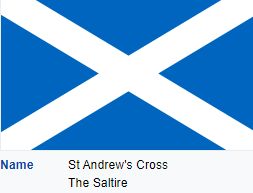 | 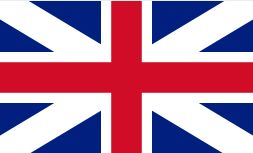 |
In 1606, the St Andrew Cross, the Flag of Scotland with its blue background was added to the Cross of St George becoming the Union Flag of Great Britain, to be used by ships at sea. In 1707 this Union Jack was formally adopted as the British Flag.
James I was followed by his son Charles 1 (1625-1649) who during the civil war (1642-1651) was executed in 1649. Oliver Cromwell (1649-1658) was followed by Charles I's son Charles II (1660-1685) returning from his exile in France, then his brother James II (1685-1688). While James II's daughters were Protestant, the birth of his son in 1688 whom he intended to raise as Catholic, forging closer links to France who were at war (1688-1697) in Europe, led to the overwhelmingly welcome invasion by his daughter Mary's Dutch husband William of Orange (the maternal grandson of Charles I), with James II's abdication and his return to France.
William of Orange The reign of William III and Mary Stuart (1689-1702) followed. Mary died in 1694, no children, before her husband.
Next Mary's sister Anne (1702-1714). None of Anne's 17 children survived.
1694 At war with France in Netherlands, Parliament was now meeting at least once annually and elections were fixed every three years.
Bank of England formed as the Government's bank for all receipts and payments. Privately owned till 1946, it was prohibited from trading in goods or merchandise.
In 1696 the Great Recoinage occurred due to almost 50% of specie content missing. Debased coins were demonetised and new full-weight coins issued.
From 1697 the inflow of gold from Brazil led to its purpose-built London vault with its bullion warehouse shifting to Threadneedle St in 1734. Its trading floor served the whole European market, later expanding from gold rushes in California, Australia and South Africa.
In 1707, a more formal union now occurred between Scotland and England forming the Kingdom of Great Britain, by two acts that were passed in the Parliament of England and the Parliament of Scotland. In 1709 it led to the closure of their mint.
Scotland, at the time of their King David I (1084-1153), had their coins at parity with English coins. But from 1356 their coins were banned as the silver content diminished. In 1392 they were half-value, by 1452 quarter-value, by 1603 the ratio was down to 12:1, in 1697 13:1. The exchange rate in 1707 was then set at 12:1.
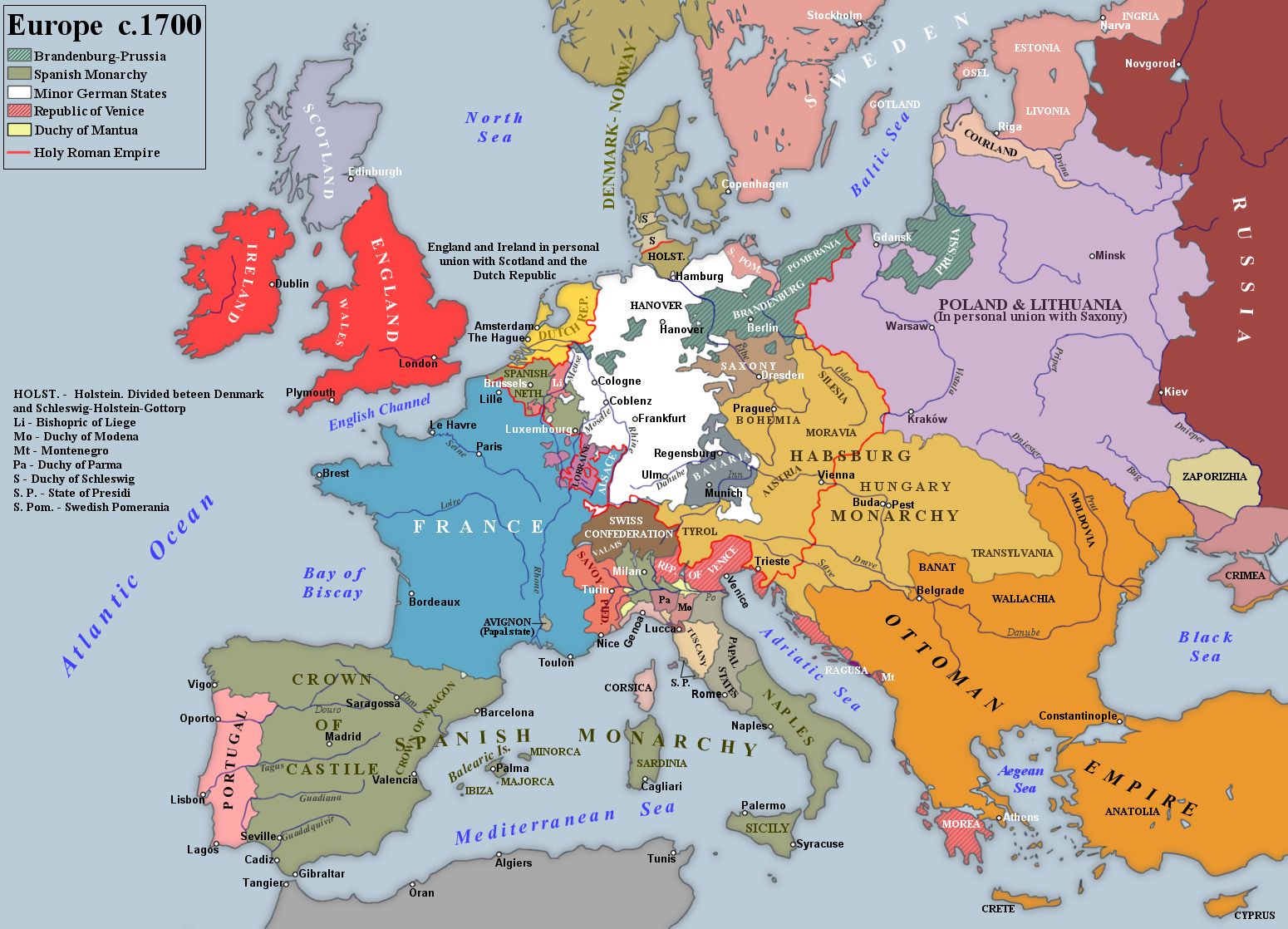
House of Hanover in 1714. George of Hanover who became George I of England was the great grandson of James I, via James's eldest daughter Elizabeth Stuart, and her daughter Sophia who had married Ernest Augustus, Elector of Hanover.
In 1715, the maximum gap between general elections was extended to seven years. Subsequently reduced to five years in 1911.
In 1721 UK's first Prime Minister, as Robert Walpole first Lord of the Treasury or Finance Minister, became known. Click here for a full list of England's Finance Ministers from the reign of Henry 1 in 1126.
George I (1714-1727) was followed by his son George II (1727-1760).
In September 1745 came the first published performance of the National Anthem, "God Save the King". It followed a planned invasion in 1744 of an army from France by James II's grandson "Bonnie Prince Charlie", Charles Stuart, known as the Young Pretender. The French invasion was cancelled when the ships were wrecked in a severe storm. In July 1745, a much smaller force was landed by France in northern Scotland where Charles Stuart raised an army. He captured Edinburgh and won a number of victories, then was defeated in England the following year in 1746. But in September 1745 the song was sung, patriotically, following the staging of a play at the Theatre Royal, Drury Lane in London.
The original first two lines were "God save great George our king, long live our noble king", which then became "God save our gracious King, William our noble King" in 1830, before becoming "God save our gracious Queen (or King), long live our noble Queen (or King)", with Queen Victoria's accession in 1837.
Back to 1760. George II was followed by his son George III (1760-1820).
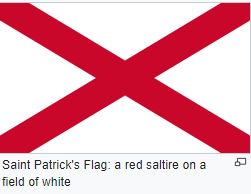 | 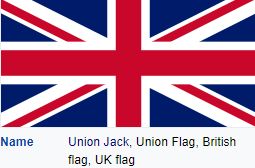 |
On 1st January 1801 came the United Kingdom of Great Britain and Ireland. The St Patrick Cross of Ireland was added to the flag to form the modern Union Jack. Until 1826 Irish coins continued, valued at 12/13 of English currency, after which they were withdrawn from circulation.
In 1922 the Republic of Ireland (Eire, or 'Southern Ireland') withdrew from the union, leaving just the northern counties of Ireland, forming the United Kingdom of Great Britain and Northern Ireland. This is the UK that remains to this day. In the south starting in 1928, the Irish Free State issued its own currency. It was at parity with British sterling until 1979. In 2002 Ireland's coins and notes became the euro.
Back to 1820. George III's son George IV (1820-1830) had no surviving children and thus was followed by his brother.
William IV (1830-1837) His reign was notable in that Parliament introduced voting reforms in 1832, extending the vote to most males over 21 holding or renting land, but now excluding all women (including wealthy ones) who could vote before. Ouch. In 1918 voting was to all males over 21, and women over 30, in 1928 to all adults over 21, in 1969 to all adults over 18.
Victoria (1837-1901) William IV had no surviving legitimate children. The next brother in line Edward, who had died in 1820, had married a Princess Victoria from the German dynasty of Saxe-Coburg-Saalfeld, with their daughter also named Victoria.
In 1840 Queen Victoria married her cousin, Prince Albert. Albert's father Ernest, the brother of Queen Victoria's mother, had earlier formed the House of Saxe-Coburg and Gotha in 1826 by ceding the town of Saalfeld, and acquisition of the district of Gotha.
Ernest was also the brother of Leopold who in 1831 had become King of a newly formed monarchy of Belgium. Belgium had been earlier known as the Spanish Netherlands (1556-1714), then the Austrian Netherlands (1714-1797), before being taken over by the French (1797-1815) then the Dutch (1815-1830).
See more ancestors
House of Saxe-Coburg and Gotha
Victoria died aged 81, having reigned 63 years and 7 months from 1837.
House of Windsor Due to anti-German sentiment in the United Kingdom during World War I, King George V changed the name of his branch from Saxe-Coburg and Gotha to Windsor, in 1917.
Some background. The original Windsor Castle was built in the 11th century after the Norman invasion of England by William the Conqueror. Since the time of Henry I, it has been used by the reigning monarch and it is the longest-occupied palace in Europe.
George was seriously injured during WW1 when thrown from his horse at a parade in 1915, and never fully recovered, with his heavy smoking exacerbating his breathing problems.
Click here for the Mountbatten family tree.
Click here for the British throne's current line of succession.
On another note, click here for some of the background to the rise of Stalin, also Hitler, Churchill, and World War 2.
** End of Page